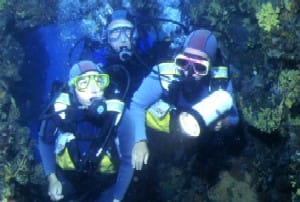“Why spend 20 hours on a plane to dive in Polynesia when here in Nice we have wonderful underwater environments just 20 minutes away by boat?” This question comes from a diving specialist. At 62, Raymond Lefèvre can be considered a wise old sage of the sport. He is in charge of the CIP (International Diving Center). The dive sites between Nice and Saint-Jean Cap Ferrat dazzle with their beauty and the water clarity that attracts divers from all over the world. They offer both easy access as the required depths are close to shore and, most importantly, a lack of current, ensuring visibility is paired with water clarity. “Contrary to popular belief, the French Riviera is not polluted,” Raymond Lefèvre quickly points out.
The paradise of underwater trekking stretches from Marseille to Menton. Raymond Lefèvre advises setting sail towards Cavalaire-sur-Mer, near Saint-Tropez. Experienced divers then embark on exploring underwater wrecks. The Rubis, a submarine of the Free France forces, sunk at 40 meters deep, attracts many of them. Under the abandoned wreck, they admire shells and crustaceans but mostly gorgonians and fauna, including rare species. Some are content with just admiring the seabed, but in general, the French Riviera offers these sea enthusiasts a wide variety of choices. All types of scuba diving are possible. The Mediterranean, a graveyard of planes and ships, is increasingly attracting freedivers—kind of a new wave. Unlike in the United States, in France, anyone can dangerously venture into underwater exploration. The responsibility actually lies with the equipment renters. Diving centers mostly exist to train the daring and inform them of the risks, but it is recommended to undergo training (see elsewhere).
“Diving? A fad? Certainly not. Fads don’t last 50 years,” claims Raymond Lefèvre. Diving first saw a wave of enthusiasts thanks to Jacques Yves Cousteau and his expeditions aboard the Calypso starting in 1950, and thus the great dive of divers began across seas and oceans. Raymond Lefèvre caught the bug later, in 1971, through a friend. “Living 300 kilometers from the sea, it was hard for me to take an interest in the underwater world,” he admits. But once he was hooked on diving, he couldn’t let it go. He explains his passion with emotion: “When I dive, I feel a sense of freedom, of lightness. I am in another universe.” Exploring the world of silence, as described by the commander in the red cap, is primarily a leisure activity, a kind of stroll. Some decide on a Sunday afternoon to cycle unknown paths just to escape. It’s exactly the same philosophy with diving. Squirrels are replaced by moray eels. Paths lined with wisterias by coral reefs. Landscapes to discover and rediscover.
Diving Must Be Learned
A small alley adjacent to the port of Nice. The pier recedes but the marine smells linger. To the port side, lies the CIP (International Diving Center), a kind of artists’ workshop. CIP offers training for anyone wanting to dive. Training starts on Monday morning and goes until Thursday. From 8:30 to 9:30, trainers discuss all the dangers and risks, particularly to the ears and lungs. At 9:30, the training continues in the sea where step by step, CIP teaches diving.
By Thursday, students will be able to dive up to 20 meters deep with an instructor. It’s level 1 certification. Diving is an expensive discipline. A full kit (suit, regulator, dive computer) costs around 1000 euros, with the addition of renting compressed air tanks. The training for level 1 certification at CIP costs 220 euros plus equipment.
CIP opened its doors in 1978, initiated by André Portelatine in association with Raymond Lefèvre. In 1989, André Portelatine died. Raymond Lefèvre has been at the helm of CIP since, training the RAID and, in the past, some members of the dearly departed Calypso. Thousands of divers have passed through Ruelle des Moulins, some of whom have become instructors themselves. “Diving without training is dangerous even with someone who masters the discipline. They won’t have the same instincts as someone who is used to guiding novices,” warns Raymond Lefèvre.
The FFESSM (French Federation for Underwater Studies and Sports) records the clubs and issues licenses. It’s a quality and safety label essential for this hobby (or sport) that requires rigor and prevention. Diving attracts more and more people on the French Riviera. Raymond Lefèvre offers an explanation: “For the past four years, there has been a real boom in underwater diving. In the summer, we are between 20 and 25 per outing. With warming and improving water quality, the fish, especially groupers, are bigger, and vegetation is more abundant. It’s therefore increasingly pleasant to dive here between Cap Ferrat and Cap d’Antibes.”


